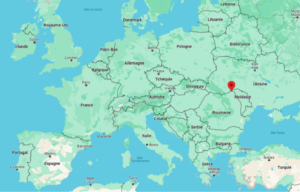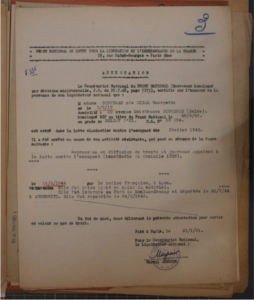Georgette CUPERMAN
Georgette Sigal was born on February 2, 1915 in the 12th district of Paris.
Birth record, Paris digital archives, 1915 register of births, ref. 12, 12 N 272
Her parents, Albert Sigal and Augustine Reisberg, were both born in Darabani, Romania, in 1878.
Google Maps
At some point, her parents emigrated to France. We do not know exactly when they arrived, but they are listed in the 1921 census of Suresnes, in the Seine department of France.
Hauts-de-Seine department digital archives, 1921 census of Suresnes, ref. ID_NUM_SUR_1921
Georgette was the youngest of four children, all of whom were born in France: Charles in 1905, Maurice in 1908 and Marie in 1911.
We do not know where, when or how Georgette met her future husband, Henry Cuperman. They had a daughter, Claude Germaine, born before they were married, on April 23, 1935 in the 14th district of Paris. Georgette was 20 years old at the time, and still a student.
Birth record, Town hall of the 14th district of Paris. Paris digital archives.
Georgette and Henry were married on September 18, 1937 in the 9th district of Paris. Henry was a furrier while Georgette, by this time, was a schoolteacher. The marriage “legitimized” their daughter Claude Germaine, who was 2 years old at the time.
Marriage record, Paris digital archives, 1937 marriage register, ref. 09, 9 M 347
When they got married, Georgette moved from her home in the 12th district to an apartment in the building next to that of her husband’s parents, in the 9th district, where Henry was living at the time. Georgette thus lived at 33 rue Navarin and Henry next door at number 31.
Rue Navarin, in the 9th district of Paris. Photo taken from Google Maps
There is no trace of Henry, Georgette and their daughter from the year in which they were married until the outbreak of the Second World War.
We know that in February 1943, Georgette and Henry joined a branch of the R.I.F. (the Résistance intérieure française or French Internal Resistance) called the the Front National de la Lutte pour la Libération et l’Indépendance de la France (the National Front for the Struggle for the Liberation and Independence of France), which was founded by the French Communist Party (PCF) in May 1941.
Statement included in Georgette Cuperman’s application for the status of deported resistance fighter © French Defense Historical Service in Caen, ref. 21 P 627 427
At around the same time, they joined the combat unit of the U.J.R.E. (Union des Juifs pour la Résistance et l’Entraide, or Jewish Union for Resistance and Mutual Aid) in Lyon. This armed group was a branch of the F.F.I. (Forces françaises de l’intérieur, or French Interior Forces).
Statement included in Georgette Cuperman’s application for the status of deported resistance fighter © French Defense Historical Service in Caen, ref. 21 P 627 427
Georgette and Henry’s resistance efforts include producing and distributing secret leaflets and newspapers.
A 1951 police report relating to their arrest reveals that Georgette and Henry had only recently arrived in Lyon when they were rounded up. They were living at 13 rue de Size. Henry was working as a tailor in a store at the same address, while Georgette was the building’s janitor.
Police report included in Georgette Cuperman’s application for the status of deported resistance fighter © French Defense Historical Service in Caen, ref. 21 P 627 427
The Lyon militia arrested Georgette and Henry on June 24, 1944, while they were having a picnic. They were both taken to Montluc jail in Lyon, where political opponents of the Vichy regime and Jews were interned.
Aerial photo of Montluc jail, Rhône departmental archives, ref. 4571 W 6
Six days later, they were transferred to Drancy camp, north of Paris. On July 4, the day after they arrived, they were assigned the serial numbers 24751 and 24752.
Drancy camp registration slip, No. 24751, Georgette Cuperman, dated July 4 1944. Shoah Memorial, Paris
Georgette and Henry were deported to Auschwitz on July 31, 1944 aboard Convoy 77, the last of the large convoys from Drancy. On October 27, 1944, Georgette was transferred to Kratzau, a forced-labor camp in Czechoslovakia.
Summary sheet included in for Georgette Cuperman’s application for the status of deported resistance fighter © French Defense Historical Service in Caen, ref. 21 P 627 427
The Russian army liberated the Kratzau camp on May 10 1945. Georgette was repatriated to France on May 22, 1945. During her medical assessment, she was diagnosed with a number of conditions common among concentration camp survivors: skin infections, emaciation, amenorrhea, diet-related problems and chronic diarrhea.
Medical examination report included in for Georgette Cuperman’s application for the status of deported resistance fighter © French Defense Historical Service in Caen, ref. 21 P 627 427
The 1946 census of Suresnes reveals that Georgette reunited with her daughter when she returned from the camps. Claude Germaine was probably kept hidden during the war, given that she was not deported with her parents. Georgette is listed as head of the family, which confirms that Henry was dead.
1946 census of Suresnes, Hauts-de-Seine digital archives, ref. 1D_NUM_SUR_1946
A note added to Henry’s birth certificate states that he died in the Stutthof camp, in annexed Poland, in December 1944.
Henry Cuperman’s birth certificate, Paris digital archives, 1910 birth register, ref. 04, 4N 209_A
In February 1951, Georgette applied to the French Ministry of Veterans’ Affairs for the status of “deported resistance fighter”, but her request was denied in October 1952, because although she had carried out acts of resistance, she had actually been arrested during a roundup on grounds of her “race”. She then applied, in March 1953, for the status of “political deportee” (meaning that she had been deported for political reasons), which she was granted on October 1, 1953.
Georgette Cuperman’s application for the status of deported resistance fighter
© French Defense Historical Service in Caen, ref. 21 P 627 427
Georgette Cuperman’s application for the status of political deportee © French Defense Historical Service in Caen, ref. 21 P 627 427
After she returned to France, Georgette joined the Amicale des déportes d’Auschwitz (Auschwitz Deportees’ Friendly Society).
Auschwitz Deportees’ Friendly Society membership card, Chemins de Mémoire website, Maurice Bleicher collection
Contributor(s)


 Français
Français Polski
Polski































